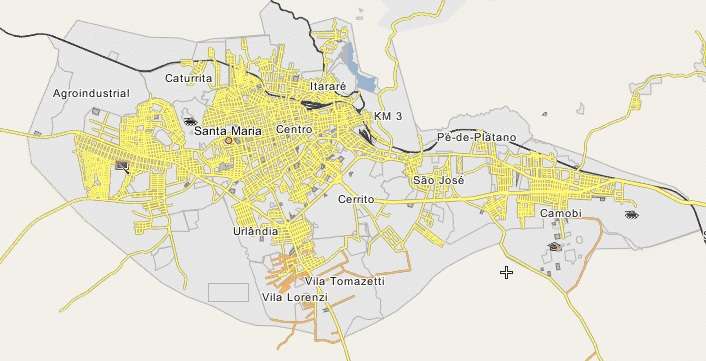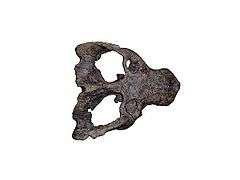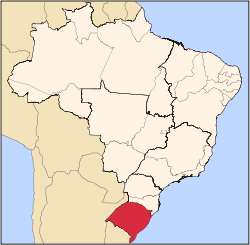Santa Maria, Rio Grande do Sul
| Santa Maria | |||
|---|---|---|---|
| Municipality | |||
.jpg) | |||
| |||
 Location in Rio Grande do Sul, Brazil | |||
 Santa Maria Location in Brazil | |||
| Coordinates: 29°41′0″S 53°48′0″W / 29.68333°S 53.80000°WCoordinates: 29°41′0″S 53°48′0″W / 29.68333°S 53.80000°W | |||
| Country |
| ||
| Region | South | ||
| State | Rio Grande do Sul | ||
| Government | |||
| • Mayor | Cesar Augusto Schirmer (PMDB) | ||
| Area | |||
| • Total | 1,823.1 km2 (703.9 sq mi) | ||
| Elevation | 113 m (371 ft) | ||
| Population (2006) | |||
| • Total | 270,073 | ||
| • Density | 150/km2 (380/sq mi) | ||
| Time zone | UTC-3 (UTC-3) | ||
| • Summer (DST) | UTC-2 (UTC-2) | ||
| Website | santamaria.rs.gov.br | ||
Santa Maria is a municipality (município) in the central region of Rio Grande do Sul, the southernmost state of Brazil. In 2007, its population was 263,403 inhabitants in a total area of 1,823 square kilometres (704 sq mi).
Importance
The city is known for the Federal University of Santa Maria and a number of other private universities and colleges.
The city annually hosts an important Roman Catholic festival dedicated to Nossa Senhora Medianeira, called "Romaria da Medianeira" (Medianeira is a name of Our Lady that was created in Venice, Italy). Every year, hundreds of thousands of people from all over Brazil join in the celebrations.
Santa Maria is the location of the Santa Maria Air Force Base of the Brazilian Air Force, which houses four units. It is also the seat of the Roman Catholic Diocese of Santa Maria.
Population
In the state of Rio Grande do Sul, Santa Maria is the fifth largest city, after Porto Alegre, Caxias do Sul, Pelotas, and Canoas. Many of the city's inhabitants are of German and Italian ancestries.[1]
It is the largest city in the central region of the state, concentrating 36.40% of this region's population. During the period between 2000 and 2010, Santa Maria had a demographic growth rate of 6.00%.
The municipality contains 10 districts. The city of Santa Maria itself is located in the urban Seat District (Distrito Sede), which is divided into 8 regiões administrativas (administrative regions), and further subdivided into 40 bairros (neighbourhoods). About 95% of the municipality's total population is concentrated in the Seat District. One of the districts is Palma.
Economy
The economy is based on services, light industry, government services, and agriculture. In 2006, there were 934 transformation industries employing 6,344 workers. Commerce employed 12,180 workers, public administration employed 4,783 workers, the health sector employed 3,799 workers, and education employed 6,362 workers. In the agricultural sector, there were 2,335 establishments employing 7,000 workers. The main activities are cattle raising with over 100,000 head in 2006, and growth of rice, corn, soybean, and wheat.[2]
Transportation
Santa Maria is a major highway and railroad hub. The city has a strategic location in connecting Brazil to other Mercosul countries, mainly through the following highways:
- BR-158 – connects Santa Maria to northern and southwestern Rio Grande do Sul, allowing access to Uruguaiana, in the Argentine border, and to Rivera, Uruguay.
- BR-287 – east-west highway, connecting the city to the capital of the state, Porto Alegre.
Railways are used for cargo transportation, mainly of agricultural products, automobile parts and food.
Santa Maria is 110 kilometres (68 mi) from the River Terminal of Cachoeira do Sul, which allows ship transport until the port of Porto Alegre through the Jacuí River, and from there to the Atlantic Ocean, through the Lagoa dos Patos.
Santa Maria Airport is located 12 km (7.5 mi) far from downtown, in the neighborhood of Camobi. It has capacity for large airplanes and offers daily flights to Porto Alegre, Santo Ângelo and Uruguaiana. The same facility is shared by the Santa Maria Air Force Base of the Brazilian Air Force.
Distances to other cities
- Santa Maria—Porto Alegre: 286 km (178 mi).
- Santa Maria—Pelotas: 337 km (209 mi).
- Santa Maria—Cruz Alta: 135 km (84 mi).
- Santa Maria—Uruguaiana: 365 km (227 mi).
- Santa Maria—Passo Fundo: 293 km (182 mi).
- Santa Maria—Caxias do Sul: 307 km (191 mi).[3]
Health and education
In 2005, there were 113 health establishments, comprising 8 hospitals with a total amount of 866 available beds. In the educational sector, there were 112 primary schools and 34 secondary schools. Six higher education institutions enrolled approximately 20,000 students. The most important are the Federal University of Santa Maria – UFSM, the Franciscan University Center – UNIFRA, and the Methodist University of Santa Maria – FAMES.[2]
Climate
Santa Maria has a humid subtropical climate and its annual average temperature is 18.9 °C (66.0 °F). In January, the warmest month, highs frequently surpass 30 °C (86 °F) with the average low dropping to 19 °C (66 °F). In June, the coldest month, highs reach 19 °C (66 °F) and lows usually go below 9 °C (48 °F), reaching up to −5 °C (23 °F), but snow is a rare occurrence. Rainfall is distributed evenly throughout the year with a monthly average of 140 millimetres (5.5 in).[4]
| Climate data for Santa Maria, Rio Grande do Sul (1961–1990) | |||||||||||||
|---|---|---|---|---|---|---|---|---|---|---|---|---|---|
| Month | Jan | Feb | Mar | Apr | May | Jun | Jul | Aug | Sep | Oct | Nov | Dec | Year |
| Record high °C (°F) | 39.3 (102.7) |
37.6 (99.7) |
37.2 (99) |
35.0 (95) |
32.4 (90.3) |
30.9 (87.6) |
30.7 (87.3) |
33.3 (91.9) |
35.4 (95.7) |
35.5 (95.9) |
40.0 (104) |
38.3 (100.9) |
40.0 (104) |
| Average high °C (°F) | 30.4 (86.7) |
30.0 (86) |
28.2 (82.8) |
25.0 (77) |
22.1 (71.8) |
19.2 (66.6) |
19.6 (67.3) |
20.3 (68.5) |
22.5 (72.5) |
24.8 (76.6) |
27.3 (81.1) |
29.5 (85.1) |
24.9 (76.8) |
| Daily mean °C (°F) | 24.2 (75.6) |
23.9 (75) |
21.9 (71.4) |
18.4 (65.1) |
15.9 (60.6) |
13.9 (57) |
14.1 (57.4) |
14.2 (57.6) |
16.5 (61.7) |
18.6 (65.5) |
21.0 (69.8) |
23.3 (73.9) |
18.8 (65.8) |
| Average low °C (°F) | 19.1 (66.4) |
19.5 (67.1) |
17.9 (64.2) |
14.5 (58.1) |
11.8 (53.2) |
9.3 (48.7) |
9.5 (49.1) |
10.4 (50.7) |
11.3 (52.3) |
13.5 (56.3) |
15.9 (60.6) |
18.3 (64.9) |
14.3 (57.7) |
| Record low °C (°F) | 11.4 (52.5) |
10.4 (50.7) |
5.9 (42.6) |
3.0 (37.4) |
0.1 (32.2) |
−2.6 (27.3) |
−2.2 (28) |
−0.6 (30.9) |
0.2 (32.4) |
3.6 (38.5) |
5.8 (42.4) |
7.2 (45) |
−2.6 (27.3) |
| Average precipitation mm (inches) | 163.0 (6.417) |
127.2 (5.008) |
136.2 (5.362) |
121.4 (4.78) |
127.5 (5.02) |
139.3 (5.484) |
144.9 (5.705) |
142.1 (5.594) |
124.3 (4.894) |
128.2 (5.047) |
120.5 (4.744) |
142.2 (5.598) |
1,616.8 (63.654) |
| Average precipitation days (≥ 1.0 mm) | 9 | 8 | 8 | 6 | 8 | 8 | 9 | 9 | 8 | 8 | 7 | 8 | 96 |
| Average relative humidity (%) | 71 | 76 | 79 | 80 | 82 | 81 | 80 | 78 | 78 | 73 | 71 | 69 | 76.5 |
| Mean monthly sunshine hours | 225.2 | 196.7 | 184.9 | 168.7 | 151.3 | 125.0 | 133.1 | 141.4 | 160.7 | 206.8 | 223.3 | 244.7 | 2,161.8 |
| Source: INMET[5] | |||||||||||||
Nicknames
Santa Maria is often referred to as the "heart of Rio Grande do Sul" (from Portuguese: "cidade coração do Rio Grande"), because the geographical center of the state is located in a rural District of Santa Maria called Passo do Verde. Santa Maria is also given the nickname of "culture city" (Portuguese: "cidade cultura"), mostly because of the local universities, which host a large number of students and young adults who engage in many cultural and political actions, social entrepreneurs, and a number of academic researchers of international reputation.
History
The first inhabitants of Santa Maria were the Minuano Indians, who lived in a region of the municipality known as Coxilha do Pau Fincado, and the Tapes, who lived in the hills.
With the arrival of Spanish and Portuguese this border region was a witness to innumerable battles between rival groups Finally in 1797 the border between the two colonies was established by a commission (1ª Subdivisão da Comissão Demarcadora de Limites da América Meridional). This commission set up camp on the site of present-day Santa Maria.
The camp was known as Acampamento de Santa Maria, later adding Boca do Monte to the name. 1828 saw the arrival of the 28th Battalion of Foreigners, made up of hired Germans to fight against the inhabitants of present-day Uruguay in the Cisplatine War. After the war many of the soldiers decided to stay in Santa Maria beginning the cycle of German colonization.
In 1857, Santa Maria was separated from Cachoeira do Sul and elevated to town (vila) status. The municipality was created on 16 December 1857 and installed on 17 May 1858.[6]
Fire
On 27 January 2013, a fire broke out in the Kiss nightclub in the city during a band performance, due to misuse of pyrotechnics, which got in direct contact with the acoustic foam used in the club. About 242 people are reported to have died after suffocation or trampling.
It has been reported that as many as 1,500 people were in the nightclub when the fire broke out and people rushed out.[7]
Quality of life
According to the United Nations (PNUD 2000), Santa Maria ranks 45th in quality of life in Brazil and 9th in the state. According to data from 2006, from Fundação de Economia e Estatística – FEE, life expectancy at birth is of 74.01 years and the demographic density of the municipality is 145.4 inhabitants per square kilometre (377/sq mi).
The level of atmospheric pollution in Santa Maria is low, since the urban area, for the most part, is composed of retail commerce and services, without polluting sectors.[8]
Sport
Santa Maria has two football teams, Inter-SM and Riograndense-SM, and one American football team, the Santa Maria Soldiers.
Paleontology

- 1) Arroio Cancela
- 2) Cabeceira do Raimundo
- 3) Arroio Passo das Tropas
- 4) Olaria Campus UFSM
- 5) Colégio Militar
- 6) Largo Padre Cargnin
- 7) Cerrito I
- 8) Cerrito II
- 9) Cerrito III
- 10) Sanga of Alemoa
- 11) Jazigo 5
- 12) Sanga do Armário
- 13) Vila dos Sargentos
- 14) Cidade dos Meninos
- 15) Vila Kennedy
- 16) Vila Caturrita
- 17) Bela Vista
- 18) Jardim Berleze
- 19) Esc. Xavier da Rocha
- 20) Silva Jardim

The city is the birthplace of paleontology in Rio Grande do Sul and Brazil. The Paleontological Sites of Santa Maria are internationally known. In 1902, a Rhynchosaur was collected in Santa Maria, one of the first fossil collections made in South America since Darwin's voyage on the Beagle between 1831 and 1836. Llewellyn Ivor Price, a Santa Maria-born paleontologist and one of the first Brazilian ones, collected a Staurikosaurus, the first Brazilian dinosaur. The city is located on a huge deposit of fossils, with more than 20 Paleontological Sites.
In October 2009, began free distribution of one thousand copies of the book Vertebrados Fósseis de Santa Maria e Região (Vertebrate Fossils of Santa Maria and surrounding regions in English). The book will be delivered to institutions, schools and libraries in Santa Maria, in order to spread the teaching of this subject in the region. The book was published by the council of the city.[9]
Already published two comic books with titles Xiru Lautério e Os Dinossauros I and II, in order to disclose the paleontology and gaucho culture among children of city and region.
References
- ↑ http://www.lagea.ig.ufu.br/xx1enga/anais_enga_2012/eixos/1068_1.pdf
- 1 2 IBGE Cidades
- ↑ Onde Fica
- ↑ Climate charts
- ↑ "Normais climatológicas do Brasil 1961-1990" (in Portuguese). Instituto Nacional de Meteorologia. Retrieved 13 April 2015.
- ↑ Prefeitura Municipal de Santa Maria
- ↑ "Tragédia em Santa Maria". Estado de São Paulo. Retrieved 31 January 2013.
- ↑ Prefeitura Municipal de Santa Maria
- ↑ Vertebrate Fossils of Santa Maria and surrounding regions.
External links
| Wikimedia Commons has media related to Santa Maria (Rio Grande do Sul). |
| Wikivoyage has a travel guide for Santa Maria (Rio Grande do Sul). |
- The city's official website (Portuguese)
- Federal University of Santa Maria – UFSM (Portuguese)
- Franciscan University Center – UNIFRA (Portuguese)
- Methodist University of Santa Maria – FAMES (Portuguese)
- Integrate Faculty of Santa Maria – FISMA (Old FASCLA) (Portuguese)
- Dioceses of Santa Maria – Article in the Catholic Encyclopedia
- 13 May Theater (Portuguese)
- Bloomsday Santa Maria – RS (BRAZIL) / since 1994 a literary party
- Cineclube Lanterninha Aurélio (CESMA) Santa Maria – RS (BRAZIL)/ since 1978
- Cooperativa dos Estudantes de Santa Maria / Santa Maria – RS (BRAZIL)/ since 1978
- Santa Maria Vídeo e Cinema – Festival / Santa Maria – RS (BRAZIL)/ since 2002
- Revista Ciência & Ambiente (Portuguese)
- Pixware Estúdio de Animação (Portuguese)

.svg.png)
